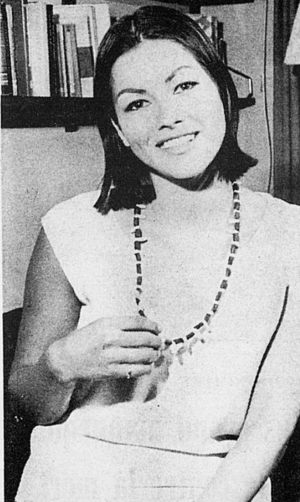Kahn-Tineta Horn facts for kids
Quick facts for kids
Kahn-Tineta Horn
|
|
|---|---|
| Kahn-Tineta ("she makes the grass wave"), or Kahentinetha | |

Kahn-Tineta Horn in 1963.
|
|
| Mohawk leader | |
| Personal details | |
| Born | April 16, 1940 (age 85) Brooklyn, New York, USA |
| Children | 4, including Waneek Horn-Miller and Kaniehtiio Horn |
Kahn-Tineta Horn was born on April 16, 1940, in New York City. She is a proud member of the Mohawk people. Kahn-Tineta is known for being a strong voice for Indigenous rights. She has worked as a government worker and was also a fashion model.
Since 1972, she has worked for the Canadian government. Her job was to help develop policies for Indigenous communities. She is part of the Mohawk Bear Clan from Kahnawake.
A Family of Activists
Kahn-Tineta Horn and her daughters were important during the Oka Crisis in 1990. This was a big standoff between Mohawks and the Canadian government. Her daughter, Waneek Horn-Miller, was hurt during this time. A powerful photo of Waneek holding her younger sister, Kaniehtiio Horn, became a symbol of the crisis.
Waneek later became a sports broadcaster. She was also co-captain of Canada's first women's national water polo team. They competed in the 2000 Summer Olympics in Sydney. Kaniehtiio is now a well-known actress in movies and TV shows. Kahn-Tineta's oldest daughter, Dr. Ojistoh Horn, is a doctor in Akwesasne.
Standing Up for Rights
In the 1960s and early 1970s, Kahn-Tineta Horn became famous. She spoke out against unfair treatment of Indigenous peoples. She also criticized government policies affecting First Nations. She believed Indigenous communities should have more control over their own lives.
She was involved in important events. In 1962, she attended a conference about poverty among Indigenous people. In 1968, she helped block the International Bridge at Akwesasne. These actions were part of bigger campaigns for Indigenous rights.
Kahn-Tineta gained media attention in 1964. She was removed from her role as a Director of the National Indian Council. She was also no longer "Indian Princess of Canada." By 1972, her ideas were being discussed in major newspapers. She was also interviewed on TV.
Spreading the Message
Kahn-Tineta Horn has appeared in two short films. These include Artisans de notre histoire, Volume 2: Les Explorateurs (1995) and David Thompson: The Great Mapmaker (1964). She also worked as the publisher for the Mohawk Nation News. This newspaper shares news and stories from the Mohawk community.
She has also served as a Director for the Canadian Alliance in Solidarity with Native Peoples. This group works to support Indigenous rights. In 2002, she gave a speech at McGill University. The speech was about how Canada's laws affected Indigenous land.
In 2006, Kahn-Tineta Horn continued her activism. She was involved in a protest against a wind farm project. She also taught a history class at Concordia University in Montreal. In 2008, she experienced a health issue at a border crossing.

